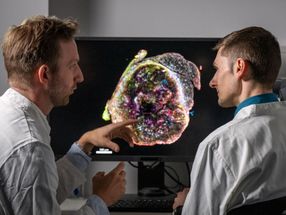New engineering method shows promise for faster healing, more cosmetically appealing skin grafts
A new way to produce engineered skin not only appears to overcome several pitfalls of current skin grafting technologies, it also speeds up the healing process, reduces scarring and produces hair. The method, outlined in STEM CELLS Translational Medicine, could represent a breakthrough for treating deep skin injuries that result from severe burns and chronic wounds.
A deep skin injury completely destroys the skin’s regenerative elements. These wounds heal by contraction, with epithelization (the process by which a new layer of skin is formed) only at the edges. The result is generally reduced joint movement and extensive scarring. In the case of an extensive lesion, healing can sometimes be unsuccessful and the lesion becomes life threatening.
Engineered tissue shows promise as a way to treat deep skin injuries, but its success depends on finding a suitable formula of stem cells for seeding the scaffold upon which the skin substitute is grown.
María Eugenia Balañá, Ph.D., principal investigator at the National Scientific and Technical Research Council (Consejo Nacional de Investigaciones Científicas y Técnicas - CONICET) in Buenos Aires, led a team of the Instituto de Ciencia y Tecnología “César Milstein” researchers in evaluating what happens when dermal papilla cells, found at the hair follicle bulb, are infused with human hair follicle stem cells (HFSCs). Her group tested three different engineered tissues using a cell-free dermal matrix as a scaffold and seeded it with human adult cell mixtures: one scaffold was seeded with HFSCs alone, another with HFSCs plus human dermal papilla cells, and a third with a mix of HFSCs and human dermal fibroblasts.
Initial laboratory results showed that the engineered tissue containing HFSC and dermal papilla cells had a more regular stratification pattern and a higher number of p63-positive basal epidermal cells, which make up the lower layer of the epidermis (skin), than those carrying HFSC and dermal fibroblasts. p63 expression is considered an epithelial stem cell marker of the epidermis.
They next grafted the dermal papilla cell-containing engineered tissue onto nude mice and found similar results: Over time the skin maintained a constant number of p63-positive cells. These results suggest that an epidermal stem cell population is maintained in the graft, allowing the physiological turnover of skin cells.
“In addition,” Dr. Balañá said, “our study suggested that the presence of dermal papilla cells in engineered skin encouraged the graft to ‘take’ and stimulated the wound healing process. Furthermore, we showed for the first time to our knowledge that the mixture of dermal papilla cells and HFSCs, both of adult human origin, were able to induce hair bud-like structures reminiscent of the hair follicle growth process.”
Dr. Gustavo José Leirós, co-author of this study, added, “The use of cells from adult origin in bioengineered skin substitutes constitutes a promising finding due to their easy access from the patient himself. These results indicate that this type of skin substitute could represent a true permanent device.”
“The development of new treatments for burn injuries and other wounds is a significant clinical need,” said Anthony Atala, M.D., editor of STEM CELLS Translational Medicine and director of the Wake Forest Institute for Regenerative Medicine. “This study demonstrates the promise of using dermal papilla cells as a component of engineered skin to produce a functional skin equivalent.”
Original publication
“Dermal Papilla Cells Improve the Wound Healing Process and Generate Hair Bud-Like Structures in Grafted Skin Substitutes Using Hair Follicle Stem Cells.”; STEM CELLS Translational Medicine 2014.
Most read news
Original publication
“Dermal Papilla Cells Improve the Wound Healing Process and Generate Hair Bud-Like Structures in Grafted Skin Substitutes Using Hair Follicle Stem Cells.”; STEM CELLS Translational Medicine 2014.
Topics
Organizations
Other news from the department science

Get the life science industry in your inbox
From now on, don't miss a thing: Our newsletter for biotechnology, pharma and life sciences brings you up to date every Tuesday and Thursday. The latest industry news, product highlights and innovations - compact and easy to understand in your inbox. Researched by us so you don't have to.
























































